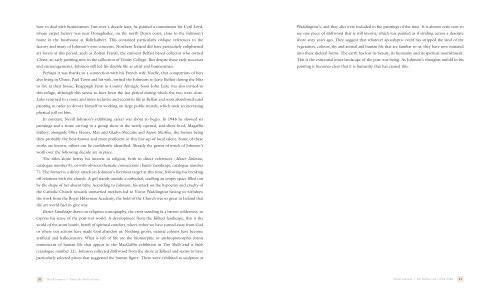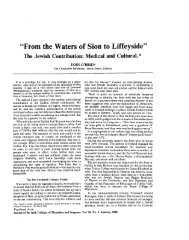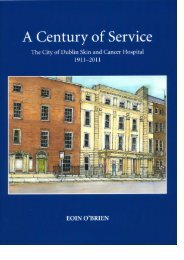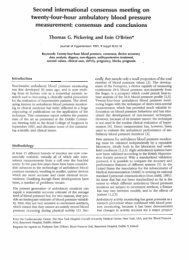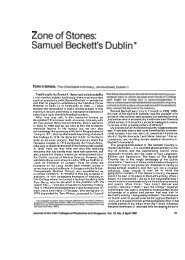Nevill Johnson: Paint the smell of grass - Eoin O'Brien
Nevill Johnson: Paint the smell of grass - Eoin O'Brien
Nevill Johnson: Paint the smell of grass - Eoin O'Brien
You also want an ePaper? Increase the reach of your titles
YUMPU automatically turns print PDFs into web optimized ePapers that Google loves.
how to deal with businessmen. Just over a decade later, he painted a commission for Cyril Lord,<br />
whose carpet factory was near Donaghadee, on <strong>the</strong> north Down coast, close to <strong>the</strong> <strong>Johnson</strong>’s<br />
home in <strong>the</strong> boathouse at Ballyhalbert. This contained particularly oblique references to <strong>the</strong><br />
factory and many <strong>of</strong> <strong>Johnson</strong>’s own concerns. Nor<strong>the</strong>rn Ireland did have particularly enlightened<br />
art lovers at this period, such as Zoltan Frankl, <strong>the</strong> eminent Belfast based collector who owned<br />
Clown, an early painting now in <strong>the</strong> collection <strong>of</strong> Trinity College. But despite <strong>the</strong>se early successes<br />
and encouragements, <strong>Johnson</strong> still led his double life as artist and businessman.<br />
Perhaps it was thanks to a connection with his French wife Noelle, that compatriots <strong>of</strong> hers<br />
also living in Ulster, Paul Terris and his wife, invited <strong>the</strong> <strong>Johnson</strong>s to leave Belfast during <strong>the</strong> blitz<br />
to live at <strong>the</strong>ir house, Knappagh Farm in County Armagh. Soon John Luke was also invited to<br />
this refuge, although this seems to have been <strong>the</strong> last period during which <strong>the</strong> two were close.<br />
Luke returned to a more and more reclusive and eccentric life in Belfast and soon abandoned easel<br />
painting in order to devote himself to working on large public murals, which took an increasing<br />
physical toll on him.<br />
In contrast, <strong>Nevill</strong> <strong>Johnson</strong>’s exhibiting career was about to begin. In 1946 he showed six<br />
paintings and a stone carving in a group show at <strong>the</strong> newly opened, and short-lived, Magaffin<br />
Gallery, alongside Olive Henry, Max and Gladys Maccabe and Aaron McAfee, <strong>the</strong> former being<br />
<strong>the</strong>n probably <strong>the</strong> best-known and most pr<strong>of</strong>icient in this line-up <strong>of</strong> local talent. Some <strong>of</strong> <strong>the</strong>se<br />
works are known, o<strong>the</strong>rs can be confidently identified. Already <strong>the</strong> germs <strong>of</strong> much <strong>of</strong> <strong>Johnson</strong>’s<br />
work over <strong>the</strong> following decade are in place.<br />
The titles alone betray his interest in religion, both in direct references (Mater Doloroso,<br />
catalogue number 8), or with obvious <strong>the</strong>matic connections (Easter Landscape, catalogue number<br />
7). The former is a direct attack on <strong>Johnson</strong>’s foremost target at this time, following his breaking<br />
<strong>of</strong>f relations with <strong>the</strong> church. A girl stands outside a ca<strong>the</strong>dral, cradling an empty space filled out<br />
by <strong>the</strong> shape <strong>of</strong> her absent baby. According to <strong>Johnson</strong>, his attack on <strong>the</strong> hypocrisy and cruelty <strong>of</strong><br />
<strong>the</strong> Catholic Church towards unmarried mo<strong>the</strong>rs led to Victor Waddington having to withdraw<br />
<strong>the</strong> work from <strong>the</strong> Royal Hibernian Academy; <strong>the</strong> hold <strong>of</strong> <strong>the</strong> Church was so great in Ireland that<br />
<strong>the</strong> art world had to give way.<br />
Easter Landscape draws on religious iconography, <strong>the</strong> cross standing in a barren wilderness, to<br />
express his sense <strong>of</strong> <strong>the</strong> post-war world. A development from <strong>the</strong> Kilkeel landscape, this is <strong>the</strong><br />
world <strong>of</strong> <strong>the</strong> atom bomb, bereft <strong>of</strong> spiritual comfort, where ei<strong>the</strong>r we have turned away from God<br />
or where our actions have made God abandon us. Nothing grows, natural colours have become<br />
artificial and hallucinatory. What is left <strong>of</strong> life are <strong>the</strong> biomorphic or anthropomorphic forms<br />
reminiscent <strong>of</strong> human life that appear in <strong>the</strong> MacGaffin exhibition in Two Shells and a Stick<br />
(catalogue number 12). <strong>Johnson</strong> collected driftwood from <strong>the</strong> shore at Kilkeel and seems to have<br />
particularly selected pieces that suggested <strong>the</strong> human figure. These were exhibited as sculpture at<br />
20 <strong>Nevill</strong> <strong>Johnson</strong> l <strong>Paint</strong> <strong>the</strong> Smell <strong>of</strong> Grass<br />
Waddington’s, and <strong>the</strong>y also were included in <strong>the</strong> paintings <strong>of</strong> <strong>the</strong> time. It is almost eerie now to<br />
see one piece <strong>of</strong> driftwood that is still known, which was painted as if striding across a desolate<br />
shore sixty years ago. They suggest that whatever apocalyptic event has stripped <strong>the</strong> land <strong>of</strong> <strong>the</strong><br />
vegetation, colours, sky and animal and human life that are familiar to us, <strong>the</strong>y have now mutated<br />
into <strong>the</strong>se skeletal forms. The earth has lost its beauty, its humanity and its spiritual nourishment.<br />
This is <strong>the</strong> existential inner landscape <strong>of</strong> <strong>the</strong> post-war being. As <strong>Johnson</strong>’s thoughts unfold in his<br />
painting it becomes clear that it is humanity that has caused this.<br />
<strong>Nevill</strong> <strong>Johnson</strong> l The Belfast years 1934–1946 21


